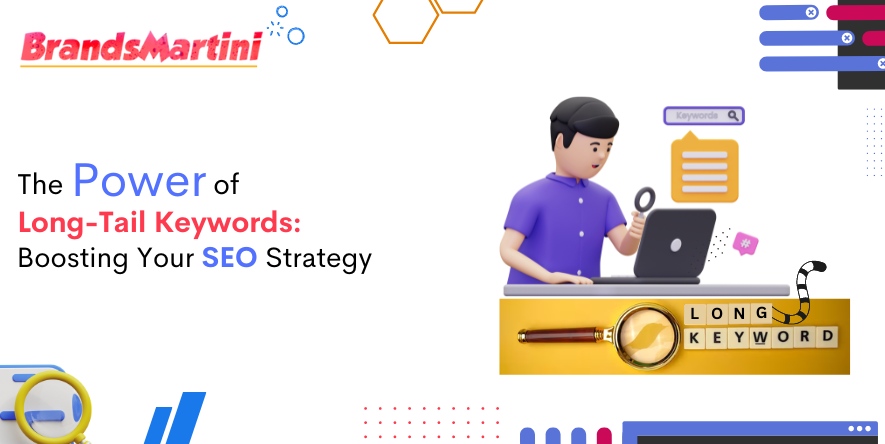Unit No. 101, 102,
Block - F, Plot No. 14,
Local Shopping Complex,
Bhera Enclave, Paschim Vihar,
New Delhi-11008783
The Power of Long-Tail Keywords: Boosting Your SEO Strategy

Best SEO Company in Delhi Maximizes Impact with Long-Tail Keywords
Welcome to the world of search engine optimization (SEO), where the right keywords can make all the difference in boosting your online visibility. In this fast-paced digital age, standing out from the crowd is crucial for businesses looking to thrive and succeed. And that’s where long-tail keywords come into play.
In today’s blog post, we’ll dive deep into the power of long-tail keywords and how they can supercharge your SEO strategy with the best SEO company in Delhi. Whether you’re a business owner or an aspiring SEO expert, understanding and harnessing these hidden gems will give you a competitive edge in driving targeted traffic to your website.
So sit back, relax, and get ready to explore the wonderful world of long-tail keywords – it’s time to take your SEO game to new heights with Brandsmartini!
Understanding Keywords and Their Importance in SEO
In the vast landscape of digital marketing, keywords are like compasses that guide users to relevant content. They act as a bridge between what people search for and what businesses have to offer. However understanding the importance of keywords in SEO goes beyond simply integrating them into your website.
The best SEO company in Delhi knows how keywords hold immense power when it comes to driving organic traffic and improving your search engine rankings. By strategically using relevant keywords throughout your website’s content, meta tags, titles, and URLs, you can signal to search engines that your site is a valuable resource for users’ queries.
By focusing on long-tail keywords that align with your business niche or target audience’s intent, you can tap into a treasure trove of untapped potential. These unique keyword combinations allow you to narrow down your audience and attract visitors who are more likely to convert into customers or leads.
To truly leverage the power of long-tail keywords, conducting thorough research is essential. Start by brainstorming potential phrases related to your industry or products/services using tools like Google Keyword Planner or SEMrush, Brandsmartini is the best SEO company in Delhi that knows about every single aspect of this field, and they are perfect in their work. Look for less competitive terms with decent monthly searches and consider user intent – what problem does someone searching for this keyword want to solve?
What Are Long-Tail Keywords?
Long-tail keywords are a powerful tool in the world of SEO. Unlike broad or generic keywords, long-tail keywords are more specific and targeted. They consist of multiple words that precisely describe what users are searching for.
By using long-tail keywords, you can attract highly relevant traffic to your website. These keywords have lower search volumes compared to broader terms, but they often have higher conversion rates because they capture users who are further along in their buying journey.
The beauty of long-tail keywords lies in their ability to bring qualified leads to your site. For example, instead of targeting the keyword “shoes,” you could use a long-tail keyword like “best-running shoes for women with high arches.” This way, you’re reaching a smaller audience but one that is specifically looking for what you offer.
Incorporating long-tail keywords into your content strategy requires careful research and analysis. Start by brainstorming ideas related to your niche and then use keyword research tools like Google Keyword Planner or SEMrush to find variations and suggestions.
Once you’ve identified relevant long-tail keywords, strategically incorporate them into your website’s content. Use them naturally in titles, headings, meta descriptions, and throughout the body text without overstuffing.
Remember that each page should target different long-tail phrases so as not to compete against yourself on search engine results pages (SERPs). This approach allows you to cover a wide range of user queries while maximizing exposure for each specific term.
Long-tail keywords provide an opportunity to improve your SEO strategy by attracting highly targeted traffic with better conversion potential. By understanding what these unique phrases are and how they can be incorporated into your content effectively, you can increase visibility on search engines and drive qualified leads organically.
Benefits of Using Long-Tail Keywords
Long-tail keywords may seem like a small piece of the SEO puzzle, but their benefits are significant. One major advantage of using long-tail keywords is that they have less competition compared to generic or short keywords. This means that by targeting specific and niche long-tail phrases, you have a higher chance of ranking well in search engine results.
Additionally, long-tail keywords provide better conversion rates. When users search for more specific terms, it indicates that they know exactly what they want. By incorporating these targeted phrases into your content, you can attract highly relevant traffic to your website and increase the chances of converting them into customers.
Moreover, using long-tail keywords can help establish your brand authority within a particular niche. By consistently creating valuable content around these specific topics, you position yourself as an expert in that area and build trust with users who are seeking specialized information.
Leveraging long-tail keywords is an effective way to boost your SEO strategy. They offer lower competition levels, higher conversion rates, improved user experience, and an opportunity for branding and authority-building within niches. Incorporating these targeted phrases into your content will help drive qualified traffic to your website while meeting the needs of potential customers
How to Identify and Research Long-Tail Keywords
When it comes to optimizing your SEO strategy, identifying and researching long-tail keywords is crucial. These highly specific keyword phrases can help you attract targeted traffic to your website and improve your search engine rankings.
To begin the process of finding long-tail keywords, start by brainstorming relevant topics or themes related to your business or industry. Think about what potential customers might be searching for when looking for products or services like yours.
In addition to using keyword research tools, don’t forget about the power of analyzing competitor websites. Look at what keywords they are targeting in their content and consider incorporating similar ones into your strategy.
Remember that long-tail keywords should be specific enough to capture niche audiences while still having sufficient search volume to drive meaningful traffic to your site. Striking this balance will help ensure that you’re attracting qualified leads who are more likely to convert into customers.
By devoting time and effort towards identifying and researching effective long-tail keywords for your SEO strategy, you’ll increase the visibility of your website in search results and bring in valuable organic traffic from users actively seeking out products or services like yours. So get started today – harness the power of these specialized phrases!
Incorporating Long-Tail Keywords into Your SEO Strategy
Incorporating Long-Tail Keywords into Your SEO Strategy
When it comes to optimizing your website for search engines, long-tail keywords play a crucial role. These are specific and highly targeted keyword phrases that capture the intent of users more accurately. By incorporating long-tail keywords into your SEO strategy, you can increase the visibility of your website and attract quality organic traffic.
One way to identify long-tail keywords is by conducting thorough research using keyword research tools like Google Keyword Planner or SEMrush. Look for phrases that have low competition but high search volume. For example, instead of targeting broad terms like “SEO services,” consider focusing on more specific phrases like “best SEO company in Delhi.”
Once you have identified relevant long-tail keywords, it’s important to strategically incorporate them throughout your website content. Include them naturally in page titles, meta descriptions, headers, and within the body text. This will not only help search engines understand what your content is about but also improve its relevance to user queries.
Remember that incorporating long-tail keywords into your SEO strategy requires ongoing monitoring and analysis of their performance. Use tools like Google Analytics or Ahrefs to track how well these keywords are ranking and driving traffic to your site.
By effectively incorporating long-tail keywords into your overall SEO strategy, you can enhance the visibility of your website in search engine results pages (SERPs) and ultimately drive more organic traffic from potential customers who are actively searching for products or services related to those specific key phrases! BrandSmartini is the best SEO company in Delhi that helps you find the best long-tail keywords, considering all aspects.
Common Mistakes to Avoid When Using Long-Tail Keywords
When it comes to using long-tail keywords in your SEO strategy, there are a few common mistakes that you should be aware of and avoid. These mistakes can hinder the effectiveness of your keyword optimization efforts and prevent you from maximizing the potential benefits of long-tail keywords.
One mistake to avoid is targeting overly competitive long-tail keywords. While it’s important to choose relevant keywords, going after highly competitive ones can make it difficult for your website to rank well in search engine results pages (SERPs). Instead, focus on finding long-tail keywords with lower competition but still have decent search volume.
Another mistake is neglecting user intent when selecting and incorporating long-tail keywords into your content. It’s crucial to understand what users are searching for and create content that directly addresses their needs or questions. By aligning your content with user intent, you’ll not only attract more targeted traffic but also increase the chances of conversions.
By avoiding these common mistakes when utilizing long-tail Keywords as part of Your SEO Strategy, you’ll increase the likelihood of boosting organic traffic, improving search engine rankings, and ultimately achieving better results for Your website or blog. Remember, it’s always important to stay up-to-date with the latest SEO best practices and
Tools and Resources for Finding and Tracking Long-Tail Keywords
When it comes to finding and tracking long-tail keywords, there are a variety of tools and resources available that can make your life much easier. One popular tool is Google Keyword Planner, which allows you to research keyword ideas, search volumes, and competition levels.
Another useful tool is SEMrush, which not only helps you find long-tail keywords but also provides insights into your competitors’ keyword strategies. This can give you a competitive edge in your SEO efforts.
Once you’ve identified your long-tail keywords, it’s important to track their performance over time. Tools like Moz or Ahrefs offer robust tracking features that allow you to monitor rankings, and organic traffic growth, and even analyze the impact of individual keywords on conversions.
Conclusion: The Impact of Long-Tail Keywords
In today’s competitive online landscape, having a strong SEO strategy is crucial for businesses looking to improve their visibility and drive organic traffic to their websites. And when it comes to optimizing your website for search engines, long-tail keywords play a significant role in boosting your rankings and attracting the right audience.
By understanding the importance of keywords and how they are used in SEO, you can leverage long-tail keywords to your advantage. These specific phrases allow you to target more specific user intent and capture highly relevant traffic that is more likely to convert into leads or sales.
The benefits of using long-tail keywords are numerous. Not only do they help you rank higher in search results but also enable you to connect with potential customers who are actively searching for what you have to offer. By incorporating these targeted phrases into your content, meta tags, headings, and URLs, you can enhance the relevance and authority of your website.
When incorporating long-tail keywords into your overall SEO strategy:
1. Focus on creating high-quality content that addresses specific user needs.
2. Optimize meta tags, headings, URLs, and image alt text with relevant long-tail keyphrases.
3. Ensure a seamless user experience by improving site speed and navigation.
4 Build high-quality backlinks from reputable sources within your niche.
5 Monitor keyword performance regularly through analytics tools.
Successful case studies have demonstrated the positive impact of implementing long-tail keywords effectively. Many businesses have experienced increased organic traffic levels as well as improved conversion rates by targeting more specific queries related directly to their products or services.
However, it’s important to avoid some common mistakes when using long-tail keywords. These include: over-optimizing your content with too many keywords, neglecting user intent and relevance, and failing to track and analyze keyword performance regularly.

- Published on
- 20/01/2024
- By
- saloni saloni
- Categories:
found us interesting?
catch up over the drink
call us for meeting
(+91) 9999-30-3344











